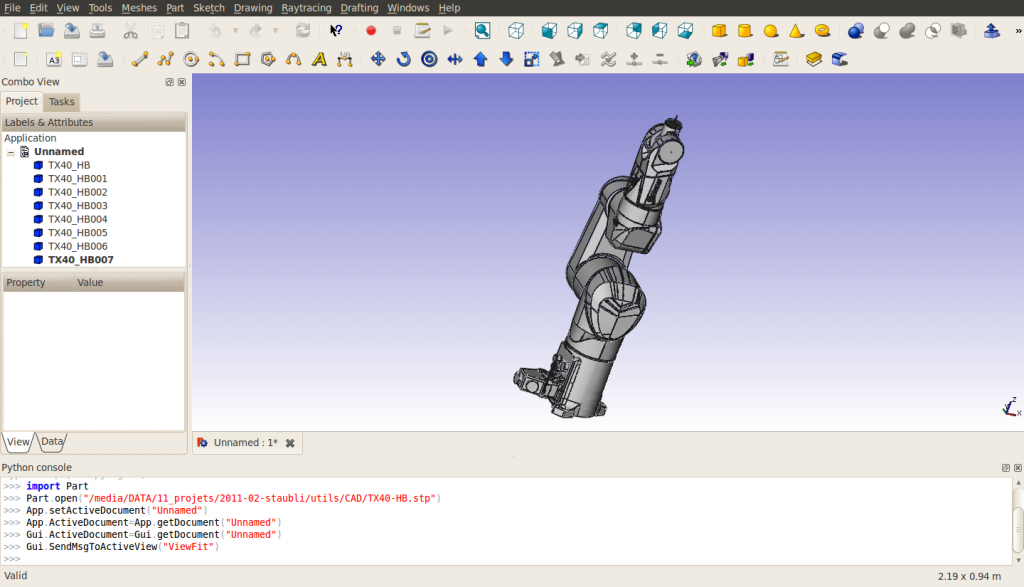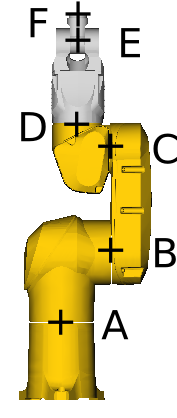|
| Tutoriel |
|---|
| Robot Workbench |
| Niveau |
| Intermediate |
| Temps d'exécution estimé |
| Auteur |
| Version de FreeCAD |
| Fichier(s) exemple(s) |
Ce tutoriel explique comment utiliser FreeCAD et le Workbench Simulation Robot pour simuler les mouvements du robot sur 6 axes.
Le tutoriel se concentre sur la création du fichier VRML utilisé pour la visualisation. La base du fichier VRML est un modèle FreeCAD. La version de FreeCAD utilisée est 0.11.4252ppa1 sur Ubuntu 32 bits.
Ouvrir un fichier, ou en créer un avec FreeCAD
Le tutoriel est basé sur un fichier-STEP d'un Stäubli TX40, vous pouvez télécharger le fichier fichier TX40-HB.stp, la méthode, devrait également s'appliquer à un modèle entièrement réalisé dans FreeCAD, cependant, je n'ai pas encore eu le temps de vérifier ce point.
Après l'ouverture du fichier, vous devriez obtenir ceci :
On notera que pour l'importation, le robot est composé de 8 formes, directement sur la racine de l'arbre du document.
La structure du fichier VRML exporté peut changer si des groupes sont utilisés. Les formes sont commandées à partir de la base de l'outil.
La dernière forme contient les axes de rotation de tous les axes du robot.
Le nom de forme de corrélation, le nom de la pièce est donné (pour l'instant (Mars 2011) par FreeCAD, FreeCAD n'importe pas encore les noms inclus dans les fichiers STEP) :
| FreeCAD name | STEP name |
|---|---|
| TX40_HB | HORIZONTAL BASE CABLE OUTLET |
| TX40_HB001 | SHOULDER |
| TX40_HB002 | ARM |
| TX40_HB003 | ELBOW |
| TX40_HB004 | FOREARM |
| TX40_HB005 | WRIST |
| TX40_HB006 | TOOL FLANGE |
| TX40_HB007 | ? |
Pour cette importation, changez le "Mode d'affichage" de chaque forme, à l'exception TX40_HB007, de "lisser" les lignes en "Ombrage" pour l'exportation VRML pour faire bonne figure. J'ai aussi changé les couleurs de [245, 196, 0] et [204, 204, 204] afin de mieux correspondre au jaune Stäubli.
Masquer TX40_HB007 car il contient les axes de tous les joints et ne peut pas être démonté.
Mesure des caractéristiques géométriques
Afin de construire la table Denavit-Hartenberg (voir 6-Axis_Robot ) et de préparer le fichier VRML, que vous avez besoin pour obtenir des caractéristiques du Robot. Pour l'instant, l'outil de mesure de FreeCAD n'est pas prêt, vous pouvez utiliser les axes inclus dans TX40_HB007 (les coordonnées sont indiquées en bas à gauche lorsque vous pointez un objet avec la souris) ou vous devez utiliser la console Python pour obtenir des informations sur la forme géométrique.
Notez que, le DH-tableau n'est nécessaire que si vous avez besoin d'utiliser la cinématique inverse, c'est à dire obtenir les coordonnées cartésiennes ou de commander le robot en coordonnées cartésiennes.
La DH-table pour ce robot est le suivant (mm, degrés et deg/s) :
| i | d | θ | r | α | θmin | θmax | Axis velocity |
|---|---|---|---|---|---|---|---|
| 1 | 320 | q1 | 0 | -90 | -180 | 180 | 555 |
| 2 | 35 | q2 - 90 | 225 | 0 | -125 | 125 | 475 |
| 3 | 0 | q3 + 90 | 0 | 90 | -138 | 138 | 585 |
| 4 | 225 | q4 | 0 | -90 | -270 | 270 | 1035 |
| 5 | 0 | q5 | 0 | 90 | -120 | 133.5 | 1135 |
| 6 | 65 | q6 | 0 | 0 | -270 | 270 | 1575 |
Le fichier csv est :
a , alpha, d , theta, rotDir, maxAngle, minAngle, AxisVelocity 0 , -90, 320, 0, 1, 180, -180, 555 225, 0, 35, -90, 1, 125, -125, 475 0 , 90, 0, 90, 1, 138, -138, 585 0 , -90, 225, 0, 1, 270, -270, 1035 0 , 90, 0, 0, 1, 133.5, -120, 1135 0 , 0, 65, 0, 1, 270, -270, 1575
Exporter en VRML
Exporter le document dans un fichier VRML.
La structure du fichier VRML est la suivante :
#VRML V2.0 utf8
Group {
children
Group {
children [
Group {
…
},
Group {
…
},
Group {
…
},
Group {
…
},
Group {
…
},
Group {
…
},
Group {
…
},
Group {
…
} ]
}
}Vous pouvez remarquer que nous avons 8 groupes indépendants, correspondants aux 8 formes.
Préparation du dossier de vrml
Toutes les formes dans le fichier vrml sont exprimées dans le cadre de base, indépendamment les uns des autres. Pour le Workbench Simulation Robot, nous avons besoin de créer une structure où, un mouvement de formes induit un mouvement de toutes les formes qui se trouveront ensuite dans la structure. Le placement des formes sera relatif à la forme précédente, nous avons donc besoin d'inclure quelques modifications à partir du système de référence absolu vers le système relatif.
Les traductions sont décrites dans le tableau suivant :
With
- A=(0, 0, 168)
- B=(0, 107.8, 320)
- C=(0, 104.15, 545)
- D=(0, 35, 601)
- E=(0, 35, 770)
- F=(0, 35, 835).
Prenons l'exemple de l'axe 4 entre le coude et avant-bras, située à D = (xd, yd, zd).
Le point d'ancrage pour l'axe de FreeCAD est :
"DEF FREECAD_AXIS4 Transform { rotation 0 1 0 0 children ["Cela correspond à une rotation autour de l'axe y. Dans le modèle CAO, la rotation se fait sur l'axe z. Ainsi, nous avons besoin d'une rotation autour de l'axe x de <math>\pi</math> avant la définition des axes de FreeCAD et de -<math>\pi</math> après. En outre, une traduction de (-xd, yd-,-zd) est nécessaire juste avant le groupe correspondant à la définition de l'avant bras, et de l'exprimer dans le cadre de référence centré par rapport à D.
Cela signifie que la traduction de (xd, yd, zd) doit être insérée avant la première rotation.
A la fin, le fichier vrml à partir de la définition du COUDE (ELBOW) vers la définition de l'avant bras (FOREARM) ressemble à ceci :
# ELBOW
Group {
… here comes the unmodified definition of ELBOW
},
Transform {
translation 0 35 601
rotation 1 0 0 1.5707963
children
DEF FREECAD_AXIS4 Transform { rotation 0 1 0 0 children
Transform {
rotation 1 0 0 -1.5707963
children
Transform {
translation 0 -35 -601
children [
# FOREARM
Group {
... here comes the unmodified definition of FOREARM
}, ]}}}},for each of the 6 axes. Eventually, the document looks like this (I don't know if I can link the file here because of copyrights):
#VRML V2.0 utf8
Group {
children
Group {
children [
# HORIZONTAL BASE CABLE OUTLET
Group {
... here comes the unmodified definition of HORIZONTAL BASE CABLE OUTLET
},
Transform {
translation 0 0 168
rotation 1 0 0 1.5707963
children
DEF FREECAD_AXIS1 Transform { rotation 0 1 0 0 children
Transform {
rotation 1 0 0 -1.5707963
children
Transform {
translation 0 0 -168
children [
# SHOULDER
Group {
... here comes the unmodified definition of SHOULDER
},
Transform {
translation 0 107.8 320
#rotation 0 0 1 0
children
DEF FREECAD_AXIS2 Transform { rotation 0 1 0 0 children
Transform {
#rotation 0 0 1 0
children
Transform {
translation 0 -107.8 -320
children [
# ARM
Group {
... here comes the unmodified definition of ARM
},
Transform {
translation 0 104.15 545
#rotation 0 0 1 0
children
DEF FREECAD_AXIS3 Transform { rotation 0 1 0 0 children
Transform {
#rotation 0 0 1 0
children
Transform {
translation 0 -104.15 -545
children [
# ELBOW
Group {
... here comes the unmodified definition of ELBOW
},
Transform {
translation 0 35 601
rotation 1 0 0 1.5707963
children
DEF FREECAD_AXIS4 Transform { rotation 0 1 0 0 children
Transform {
rotation 1 0 0 -1.5707963
children
Transform {
translation 0 -35 -601
children [
# FOREARM
Group {
... here comes the unmodified definition of FOREARM
},
Transform {
translation 0 35 770
#rotation 0 0 1 0
children
DEF FREECAD_AXIS5 Transform { rotation 0 1 0 0 children
Transform {
#rotation 0 0 1 0
children
Transform {
translation 0 -35 -770
children [
# WRIST
Group {
... here comes the unmodified definition of WRIST
},
Transform {
translation 0 35 835
rotation 1 0 0 1.5707963
children
DEF FREECAD_AXIS6 Transform { rotation 0 1 0 0 children
Transform {
rotation 1 0 0 -1.5707963
children
Transform {
translation 0 -35 -835
children [
# TOOL FLANGE
Group {
... here comes the unmodified definition of TOOL FRAME
},
Group {
... here comes the unmodified definition of TX40_HB007
} # "]" was deleted from this line
]}}}},
]}}}},
]}}}},
]}}}},
]}}}},
]}}}},
] # this is the "]" deleted from the line above
}
}Voici un patch pour obtenir un fichier vrml convenant à la simulation du robot :
7a8
> # HORIZONTAL BASE CABLE OUTLET
95968a95970,95981
> Transform {
> translation 0 0 168
> rotation 1 0 0 1.5707963
> children
> DEF FREECAD_AXIS1 Transform { rotation 0 1 0 0 children
> Transform {
> rotation 1 0 0 -1.5707963
> children
> Transform {
> translation 0 0 -168
> children [
> # SHOULDER
128428a128442,128453
> Transform {
> translation 0 107.8 320
> #rotation 0 0 1 0
> children
> DEF FREECAD_AXIS2 Transform { rotation 0 1 0 0 children
> Transform {
> #rotation 0 0 1 0
> children
> Transform {
> translation 0 -107.8 -320
> children [
> # ARM
206503a206529,206540
> Transform {
> translation 0 104.15 545
> #rotation 0 0 1 0
> children
> DEF FREECAD_AXIS3 Transform { rotation 0 1 0 0 children
> Transform {
> #rotation 0 0 1 0
> children
> Transform {
> translation 0 -104.15 -545
> children [
> # ELBOW
267111a267149,267160
> Transform {
> translation 0 35 601
> rotation 1 0 0 1.5707963
> children
> DEF FREECAD_AXIS4 Transform { rotation 0 1 0 0 children
> Transform {
> rotation 1 0 0 -1.5707963
> children
> Transform {
> translation 0 -35 -601
> children [
> # FOREARM
417854a417904,417915
> Transform {
> translation 0 35 770
> #rotation 0 0 1 0
> children
> DEF FREECAD_AXIS5 Transform { rotation 0 1 0 0 children
> Transform {
> #rotation 0 0 1 0
> children
> Transform {
> translation 0 -35 -770
> children [
> # WRIST
422053a422115,422126
> Transform {
> translation 0 35 835
> rotation 1 0 0 1.5707963
> children
> DEF FREECAD_AXIS6 Transform { rotation 0 1 0 0 children
> Transform {
> rotation 1 0 0 -1.5707963
> children
> Transform {
> translation 0 -35 -835
> children [
> # TOOL FLANGE
435627c435700,435707
< } ]
---
> }
> ]}}}},
> ]}}}},
> ]}}}},
> ]}}}},
> ]}}}},
> ]}}}},
> ]

